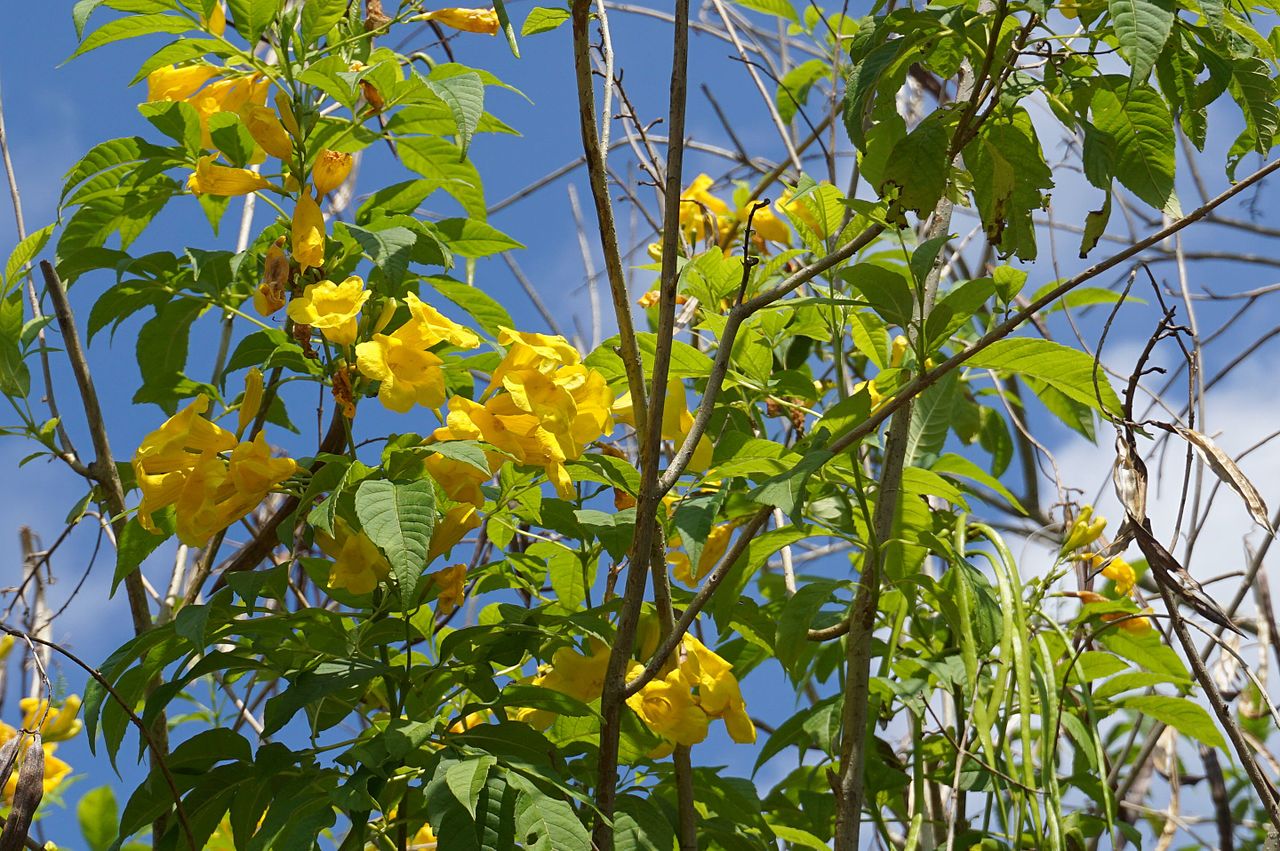Tecoma stans

|
|
Tecoma stans Common Names: Tecoma, yellow bells, yellow elder,
yellow trumpetbush, Chinese trumpet creeper, ginger-Thomas, esperanza Scientific
Classification Kingdom: Plantae Clade: Tracheophytes Clade: Angiosperms Clade: Eudicots Order: Lamiales Family: Bignoniaceae Genus: Tecoma Species: T. stans Binomial Name: Tecoma stans (L.) Juss. ex Kunth Synonyms: Bignonia stans L., Bignonia incisa Hort. ex DC., Bignonia frutescens Mill. Morphological Description Tecoma stans,
commonly known as yellow bells or yellow elder, is a semi-evergreen shrub or
small tree typically growing to heights of 3–10 meters, with exceptional
specimens reaching up to 12 meters in favorable conditions (Kew Science, 2024).
The trunk is short, often multi-stemmed, with smooth, light gray to brown bark
that becomes fissured and darker with age, reaching diameters of 20–30 cm
(Singh et al., 2024). The dense, spreading crown is supported by slender,
arching branches. Leaves are opposite, pinnate, 10–25 cm long, composed of 5–13
lanceolate leaflets, each 2–10 cm long and 1–3 cm wide, with serrate margins
and a glossy green surface that may turn bronze in cooler weather (Tropical
Plants Database, 2024). Flowers are bright yellow, trumpet-shaped, 3–6 cm long
and 2–3 cm wide, fragrant with a faint honey-like scent, borne in terminal or
axillary clusters of 5–15 blooms, primarily in spring and fall, though
flowering can occur year-round in tropical climates (UF/IFAS Extension, 2018).
Fruits are slender, linear capsules, 10–20 cm long and 0.5–1 cm wide,
transitioning from green to brown as they mature, splitting to release numerous
flat, winged seeds, 6–8 mm long (Burkill, 2000). Distribution and Habitat Tecoma stans is
native to the Americas, spanning from the southwestern United States (e.g.,
Texas, Arizona, New Mexico) through Mexico, Central America (e.g., Guatemala,
Honduras), and South America (e.g., Peru, Argentina) to the Caribbean (e.g.,
Bahamas, Cuba) (Kew Science, 2024). It has been widely introduced and
naturalized in tropical and subtropical regions, including Southeast Asia
(e.g., India, Philippines), Africa (e.g., South Africa, Kenya), northern
Australia, and Pacific Islands (e.g., Hawaii) (CABI, 2024). The species thrives
in well-drained soils—clay, sand, or loam—with a pH range of 6.0–8.0,
preferring full sun exposure and tolerating drought with annual rainfall as low
as 300 mm (Tropical Plants Database, 2024). It grows at elevations from sea
level to 2,000 meters, commonly found in disturbed areas, roadsides, rocky
hillsides, and open woodlands, reflecting its adaptability to arid and
semi-arid conditions (Singh et al., 2024). Its drought tolerance and rapid
growth make it a favored ornamental in xeriscaping. Ethnopharmacology Tecoma stans has
a rich history in traditional medicine, particularly in Mexican and Central
American folk practices, attributed to its diverse bioactive compounds,
including monoterpene alkaloids (e.g., tecomine, tecostanine), flavonoids
(e.g., apigenin, luteolin), and phenolic acids (e.g., chlorogenic acid) (Anand
& Basavaraju, 2021). Below are key ethnopharmacological uses supported by
research: · Antidiabetic Effects: In Mexico, leaf infusions are used to
manage diabetes; ethanolic leaf extracts (200–400 mg/kg) reduced blood glucose
by 60–70% in streptozotocin-induced diabetic rats by inhibiting intestinal
α-glucosidases, with tecomine enhancing glucose uptake in adipocytes
(Aguilar-Santamaría et al., 2009). · Anti-inflammatory and Analgesic: In Guatemala, leaf decoctions relieve pain
and inflammation; methanol extracts (300 mg/kg) reduced carrageenan-induced paw
edema by 50% in rats and acetic acid-induced writhing by 45%, linked to
flavonoids and phenolic acids (Agyare et al., 2013). · Antimicrobial Activity: In the Caribbean, flower extracts treat
infections; volatile oils from flowers showed an MIC of 125 μg/mL against Staphylococcus aureus and Escherichia coli, supporting its use for oral and skin
infections (Mohammed et al., 2019). · Antivenom Properties: In Central America, leaves are applied to
snake bites. · Digestive Health: In Panama, bark infusions aid digestion;
aqueous bark extracts reduced intestinal motility by 40% in mice, attributed to
tannins and their astringent properties (Ezenyi & Igoli, 2019). These traditional uses
are substantiated by over 120 identified compounds, with alkaloids and
phenolics driving its pharmacological efficacy (Anand & Basavaraju, 2021). ⚠ Toxicity Profile: Tecoma stans itself is not toxic and is widely used
medicinally and as fodder; however, honey produced from its nectar can be
poisonous due to alkaloid contamination (e.g., tecomine), potentially causing
nausea, dizziness, or neurological symptoms in humans (Tropical Plants
Database, 2024). The plant’s seeds and woody parts may cause digestive upset if
ingested in large quantities, and its pollen can trigger allergies in sensitive
individuals (Singh et al., 2024). Additional Uses · Ornamental Value: Its vibrant yellow flowers and drought
tolerance make it a popular ornamental in gardens, parks, and urban landscapes,
often used in xeriscaping and as a hedge (UF/IFAS Extension, 2018). · Ecological Impact: As an invasive species in Africa, Asia,
Australia, and Pacific Islands, it forms dense thickets that outcompete native
flora, reducing biodiversity and altering ecosystems (CABI, 2024). · Fodder and Timber: Leaves are used as fodder for goats and
cattle in Mexico, providing 10–15% crude protein, while the lightweight wood
(density 0.4–0.6 g/cm³) is crafted into small tools and ornaments (Burkill, 2000). References
External Links More Pictures |
|
| Compounds of Tecoma stans |
|
| References |